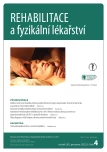Evaluation of the effect of complex rehabilitation care for children with cerebral palsy after the first year of operation of the new code OD 0035 in Sanatoria Klimkovice
Authors:
Holaňová R. 1; Willaschková L. 1; Tomášková H. 2; Žiaková E. 3
Authors‘ workplace:
AquaKlim s. r. o., Sanatoria Klimkovice, Ostrava
1; Ústav epidemiologie a ochrany veřejného zdraví, Lékařská fakulta, Ostravská univerzita
2; Katedra Fyzioterapie, Fakulta ošetrovateľstva a zdravotníckych odborných štúdií, Slovenská zdravotnícka univerzita v Bratislave, Slovenská republika
3
Published in:
Rehabil. fyz. Lék., 30, 2023, No. 4, pp. 189-195.
Category:
Original Papers
doi:
https://doi.org/10.48095/ccrhfl 2023189
Overview
The authors present the first experience with the new treatment method – comprehensive intensive medical rehabilitation for children with cerebral palsy which the Ministry of Health designates with the code 00035.This care is therefore covered by public health insurance funds. The effect of the therapy is assessed by the standardized GMFM-88 (gross motor function measure) test. A total of 32 children with an average age of 8.4 years were evaluated in the group. Children with degree III of psychomotor disability according to the GMFCS (gross motor function classification system) predominated. The effect of therapy taking place twice a year with a rehabilitation stay of 1 month is statistically significant, not only in the total score, but also in the individual items of the GMFM test. The improvement therefore concerns movement skills in all postural positions. Children benefit not only on the level of movement, but also on the level of development of cognitive functions and in the overall development trend.
Keywords:
cerebral palsy – neurorehabilitation – effect of the therapy – Sanatoria Klimkovice
Sources
1. Komárek V, Zumrová A, Glosová L. et al. Dětská neurologie. Praha: Galén 2008.
2. Morris C. Definition and classification of cerebral palsy: a historical perspective. Dev Med Child Neurol Suppl 2007; 109 : 3–7. doi: 10.1111/ j.1469-8749.2007.tb12609.x.
3. CanChild Centre for Childhood Disability Research, Institute for Applied Health Sciences, McMaster University 2007. Gross motor function classification system: rozšířený a upravený. [online]. Dostupné z: www.https:/ / canchild.ca/ system/ tenon/ assets/ attachments/ 000/ 000/ 065/ original/ GMFCS-ER_Translation-Czech.pdf.
4. Gross Motor Function Measure. [online].Available from: www. https:/ / canchild.ca/ system/ tenon/ assets/ attachments/ 000/ 003/ 355/ original/ gmfm-88_and_66_scoresheet-V4.pdf.
5. Klobucká S, Žiaková E, Klobucký R. Vplyv prostredia virtuálnej reality počas roboticky asistovaného lokomočného tréningu na motorické funkcie pacientov s detskou mozgovou obrnou. Česk Slov Neurol N 2013; 76(109): 702–711.
6. Llamas-Ramos R, Sánchez-Gonzáles JL, Llamas-Ramos I. Robotic systems for the physiotherapy treatment of children with cerebral palsy:a systematic review. Int J Environ Res Public Health 2022; 19(19): 5116. doi: 10.3390/ ijerph 19095116.
7. Russell D, Rosenbaum P, Cadman D et al. The Gross motor function measure: a means to evaluate the effect of physical therapy. Dev Med Child Neurol 1989; 31(3): 341–352. doi: 10.1111/ j.1469-8749.1989.tb04003.x.
Labels
Physiotherapist, university degree Rehabilitation Sports medicineArticle was published in
Rehabilitation & Physical Medicine

2023 Issue 4
Most read in this issue
- Professional voice disorders and possibilities of treatment
- Validation of the Czech Movement Imagery Questionnaire-Revised Second Version in stroke survivors
- Comparison of methodologies in degenerative changes of the cervical spine
- Benefit of acupressure in the treatment of migraine with focus on the quality of life
